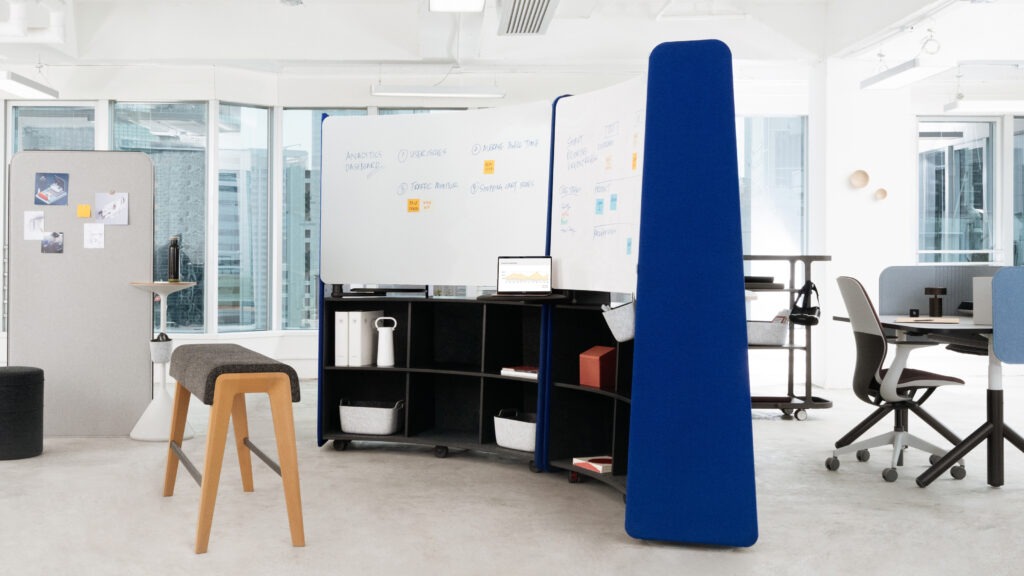From sustainability to the need to move less from one’s home to the workplace, we can foresee a future in which large corporate buildings will disappear and small, more diffuse spaces will emerge. Hybrid workplaces consists of augmented and virtual reality that will be widely used, as well as platforms for remote training.
All to support the 15-minute city, as outlined by various initiatives in Europe. We may not be ready, but the healthcare crisis has forced the emergence of a model that can wait no longer, the so-called hybrid workplace.
The economic crisis linked to the pandemic has had a negative impact on employment. Despite the gradual recovery, the world of work is set to change significantly. This means that it becomes necessary to develop new skills, with a particular focus on human capital.
The pandemic has only accelerated processes of great change already underway in the workplace and mainly related to new technologies, digitalization, well-being, and support of the individual and the environment. So, among new professions, unknowns, and uncertainties, what future awaits the world of work?
In a rapidly changing sector such as that of the professions, to be able to find one’s place and express one’s potential to the full, an increasingly important role is played by hitherto little-requested skills, the so-called soft skills (or transversal skills). Hybrid workplaces provide spirit of adaptation, inventiveness, problem solving, active listening, understanding of others, to name but a few, are now the key to fast-moving change.
To explain how profound the change in the world of work is, suffice it to say that more than half of today’s primary and secondary school students will tomorrow be working in professions that are currently unknown. These will be new jobs that are different from the traditional ones, based much more on digital and soft skills, as well as on concepts such as diversity and inclusion.
The work of the future will be formed into hybrid workplaces. The working day will no longer be based so much on working hours, but on objectives achieved. And, in the new normal, leaders will have to demonstrate a high emotional quotient and be much more concerned about the well-being of their employees than before.
In a recent study called “Resetting Normal: Defining the New Era of Work“, carried out by The Adecco Group, 14,800 workers and managers from 25 countries were involved, who had to face enormous changes in the way they work due to the health emergency. The aim was to capture changes in expectations and attitudes. The main themes that emerged outline what will be the trends in work in the future.
First and foremost, its hybrid dimension. No longer only remote, but also not completely in presence. As many as eight out of ten of those interviewed believe that hybrid work offers new opportunities to create a more inclusive professional environment open to diversity, favoring the inclusion of people with disabilities and employees with children.

Hybrid Workplaces are here to stay
It is no coincidence that workers would like to maintain the flexibility in working hours and workplaces gained during the 2020s. But many are also asking for more, wanting a shorter working week. In fact, six out of ten workers believe they can do their jobs in less than 40 hours a week. And 72% believe that employers should reschedule their working hours. And the demand for flexibility is “universal”.
It comes from all generations, from young to old. And it is transversal with respect to gender. Although among women, especially mothers, the demand for flexibility (80%) is the highest ever. Business leaders themselves agree: 77% have no doubts about the benefit that the company could derive from ensuring greater flexibility.
In this context, managers are also expected to be able to ‘reconnect’ with workers, even at a distance, by reinventing a new ‘hybrid’ corporate culture. What is clear is that we will no longer return to the office in the previous way. The pandemic has accelerated existing trends to the point where they cannot be ignored, and future success will depend on how workers and leaders will adapt and respond to them.
The pandemic has generated many questions for commercial property owners, developers and tenants alike: what is the role of the workplace? It is to be expected that some of the changes we are currently experiencing are temporary in nature while others will leave lasting impacts.
The development of ubiquitous technology has allowed organizations to perform collaborative tasks virtually. Mobile devices have similar memory and computing power as desktop PC’s, allowing us to work away from our desk. There is improved fluency with virtual and platform based collaboration tools by staff, especially those of younger generations.
Technology like mobile virtual desktops may replace bulky laptops and computers, enabling mobility inside and outside of an office building. Digital collaboration platforms have created an opportunity to explore a virtual, augmented, and mixed reality, along with new platforms and digital services for collaboration and communication at work. These tools are leading to new ways of working and sharing with colleagues, clients, and customers.
15 minutes to go
If, therefore, remote working becomes a freely accessible mode even when offices begin to reopen, the pattern of cities is bound to change. The flow of people coming to work will diminish, because employees will carry out activities involving concentrated or individual work from home, and will rarely go to the office. The hive office gives way to smaller, more territorial hubs. Hence the concept of the polycentric city, where everything is reachable within 15 minutes.
The ‘city of 15 minutes’ is a concept developed by French-Colombian Sorbonne urban planner Carlos Moreno and applied on an experimental basis in Paris. The “ville du quart d’heure” envisages reorganizing urban spaces so that citizens can find everything they need to live within a 15-minute walk of their homes: work (including co-working), shops, health facilities, schools, sports facilities, cultural spaces, bars and restaurants, and meeting places. In this way, people do not have to take the car or public transport, reducing traffic and pollution, reappropriating time lost in travel and rediscovering sociality in their neighborhood. This is why the hybrid workplaces are something that can be managed from employers and employees. Definitely it can make people more productive, specially when they can have quality time with their families during the week.



